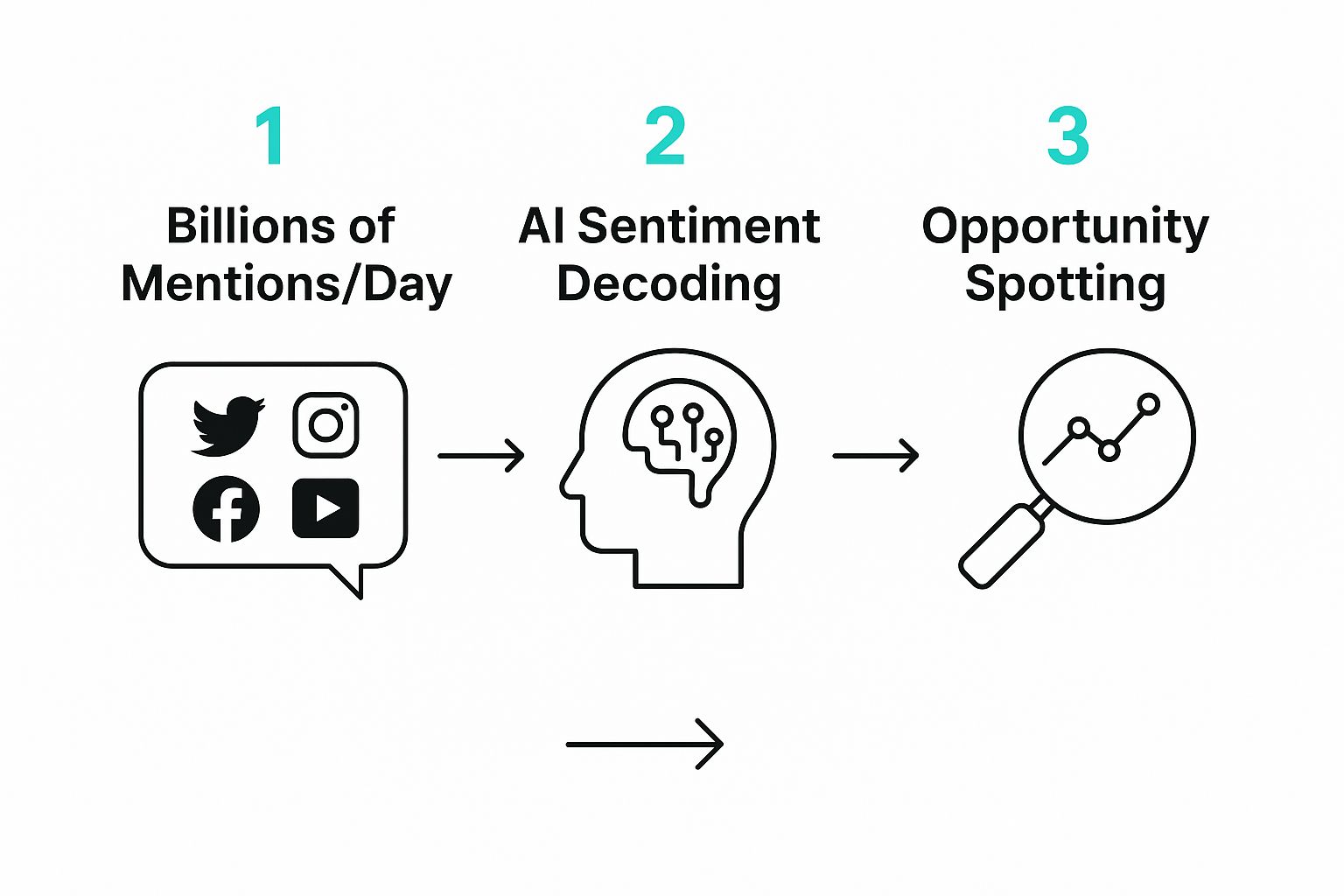Brand Monitoring Social Media: Boost Your Brand's Presence

Listening to what people say about your brand on social media is no longer just about putting out fires. It’s a core part of any smart business strategy, helping you understand how customers really feel, catch trends as they happen, and protect your hard-earned reputation. We've moved way past simple mention tracking; this is about proactive business intelligence.
Why Social Media Brand Monitoring Matters Now
Let's be real—manually keeping up with the billions of conversations happening online every day is impossible. That’s why modern monitoring has become a strategic necessity, not just a reactive task for damage control.
By 2025, more than 5.42 billion people will be using social media, and they'll be active on an average of 6.8 different platforms each month. This firehose of data requires sophisticated, AI-powered tools to make any sense of it all. To learn more about how this has changed over the years, Sprinklr offers some great insights into its evolution.
Protecting your brand’s image is everything, and that's where effective social media reputation management comes in. It's about taking all that online chatter and turning it into a real competitive advantage. We dive deeper into how this impacts your brand in our guide to social media reputation monitoring: https://intently.ai/blog/social-media-reputation-monitoring.
This flow chart gives you a great visual of how modern tools can sift through billions of daily mentions and surface genuine opportunities for your business.

The big takeaway here? Technology is what closes the gap between overwhelming data and clear, actionable insights for your business.
From Data Overload to Strategic Advantage
The real magic of social media brand monitoring is its power to decode public perception at a massive scale. You get to stop guessing what your customers think and start listening to their unfiltered opinions directly. This intelligence is gold, and it can inform decisions across your entire company.
Here’s how it plays out in the real world:
- Product Development: Are people constantly asking for a certain feature? Or maybe complaining about the same bug? This feedback is a direct line to improving your product roadmap.
- Marketing Campaigns: Listen to the exact words and phrases your customers use. This authentic language can make your ad copy and messaging resonate so much more powerfully.
- Customer Service: Spot and address customer issues before they blow up into a bigger crisis. It’s about being proactive, not just reactive.
When you listen closely to social conversations, you’re not just managing your reputation—you’re building a more customer-focused business from the ground up. It’s the difference between hearing a wall of noise and finding the signal that moves you forward.
Setting Goals and Defining What to Track

Before you even think about which tool to use, you need to figure out what you're actually trying to accomplish. A smart brand monitoring social media strategy isn't about collecting every single mention you can find—it's about gathering the right mentions that connect to real business goals.
Vague goals like "improving our brand image" sound nice, but they're impossible to measure. You can't prove you've done it.
Instead, you have to get specific. A real, tangible goal sounds more like, "Let's cut negative sentiment by 20% this quarter," or "I want to identify five key customer pain points each month to share with the product team." This simple shift turns monitoring from a passive, time-wasting activity into a focused mission to gather intelligence. Every goal you set should immediately answer the question, "How will this data help us make better decisions?"
Identifying Your Core Keywords
Once your goals are crystal clear, you can build a focused list of keywords. Think of it as casting a wide but precise net. It's about more than just your company name, because people talk about brands in all sorts of ways.
A solid keyword list should always include:
- Brand and Product Names: Don't forget common misspellings or abbreviations. If your product is "SyncUp," you better be tracking "Sync Up" and even "SynkUp."
- Executive and Key Personnel: Keep tabs on the names of your CEO, CTO, or other public-facing leaders. Their personal reputation is tied to the company's.
- Campaign Hashtags and Slogans: You need to monitor both your official campaign hashtags and any organic ones that pop up to see what kind of impact you're really making.
- Competitor Mentions: Watching your direct competitors is a goldmine. You get to see their customer feedback, marketing moves, and how they're positioning themselves in the market.
By taking the time to nail down your goals and keywords upfront, you guarantee that every alert and report you get is actually relevant. This planning phase is what prevents data overload and turns your dashboard from a wall of noise into a source of truly actionable insights.
Connecting Goals to Your Monitoring Keywords
Use this framework to align your business objectives with the specific keywords and metrics you need to track on social media.
| Business Goal | Keywords to Monitor | Key Metrics to Track |
|---|---|---|
| Protect Brand Reputation | Company name (and misspellings), CEO name, key product names, any past negative terms. | Sentiment Analysis (positive vs. negative), Share of Voice, Volume of Mentions. |
| Improve Customer Service | Phrases like "can't log in," "customer support," "help with [product]," "[brand name] down." | Response Time, Number of Unanswered Mentions, Sentiment on Support-Related Posts. |
| Generate New Leads | Terms like "recommendations for [your industry]," "alternative to [competitor]," "[your solution type] software." | Mentions with Purchase Intent, New Follower Growth from Engagement, Link Clicks. |
| Track Competitor Activity | Competitor brand names, their product names, hashtags from their latest campaigns. | Competitor's Share of Voice, Sentiment Towards Competitors, Key Themes in Competitor Mentions. |
This simple exercise connects every piece of your brand monitoring social media efforts directly back to something that matters for the business. It ensures your time and resources are always well-spent.
Configuring Your Monitoring Toolkit

Alright, you've got your goals mapped out and a solid list of keywords. Now it's time to put them to work and start filtering the internet’s endless noise down to the conversations that actually matter.
This is where you set up your monitoring streams, and it’s the most critical part of effective brand monitoring social media. Get this right, and you'll avoid drowning your team in thousands of irrelevant alerts.
Whether you're using a dedicated platform like Brand24 or starting with something more basic, the core idea is the same: be ruthlessly specific. This is where a little bit of Boolean logic becomes your secret weapon.
Mastering Your Search Queries
Think of Boolean operators as simple commands that tell your monitoring tool exactly what to look for—and what to ignore. They’re the difference between tracking mentions of Apple the tech giant and getting pinged every time someone bakes an apple pie.
You really only need to know a few to get started:
- AND: Narrows your search. Both terms must be present (e.g., "customer service" AND "complaint").
- OR: Broadens your search. It will find mentions of either term (e.g., "slow" OR "buggy").
- NOT: Excludes specific terms from your results (e.g., "Jaguar" NOT "car").
- Parentheses ( ): Let you group terms to build more complex queries, like
(customer service OR support) AND (complaint OR issue).
This Venn diagram from Wikipedia does a great job showing how these operators work to combine or isolate different sets of data.

Using them correctly helps you zero in on the most relevant conversations with surgical precision. It's a game-changer.
A well-crafted Boolean query is the foundation of a successful monitoring strategy. It ensures that every alert landing in your inbox is a potential opportunity, not just another distraction to be archived.
For instance, you can set up alerts to get notified when a major influencer mentions your brand or to track a sudden spike in negative sentiment for crisis management. This level of precision also helps you spot sales opportunities. If you're looking to find customers actively searching for solutions, our guide to AI lead generation tools explores how to apply these same principles to find qualified leads.
From Raw Data to Actionable Insights
Collecting thousands of brand mentions is a great start, but let's be honest—data is just noise until you give it meaning. This is where the magic happens, where you turn a firehose of social media posts into a clear picture of your brand’s health. It’s about transforming raw information into real strategic intelligence.
The heart of this process is sentiment analysis.
AI-powered tools are fantastic at flagging mentions as positive, negative, or neutral, especially when you’re dealing with a high volume of them. But relying entirely on automation can be a bit of a gamble. Machines are notorious for missing human nuance like sarcasm or cultural context. A comment like, "Great, another software update that broke my workflow," could easily slip through the cracks and be miscategorized.
That’s exactly why a human touch is non-negotiable for refining your data and making sure it's accurate.
Spotting Patterns in the Chatter
Once you have a solid handle on sentiment, you can start connecting the dots. The real payoff in brand monitoring social media comes from pulling out recurring themes and patterns from the noise. Instead of getting bogged down by every single mention, you need to zoom out and see the bigger picture.
Are you noticing that negative feedback always seems to circle back to a specific product feature? That’s a crystal-clear signal for your product team. Is a recent marketing campaign sparking a wave of positive comments? Your marketing department needs to know what’s hitting the mark.
The goal isn’t just to react to individual comments but to understand the collective voice of your customers. This holistic view is what empowers you to make smarter, data-driven decisions across your entire business.
To really get value out of all this, you need a strong grasp of social media analytics. This is how you link what people are saying online to actual business outcomes, like informing product development, sharpening your marketing messages, and improving customer service.
In fact, teams that use social listening tools report being up to twice as confident in their social media marketing ROI. By looking at metrics beyond just the number of mentions—like share of voice and overall sentiment—brands can gain a serious competitive edge. For a deeper dive on these metrics, Sprout Social’s in-depth research is a fantastic resource.
Putting Social Insights to Work Across Your Strategy

Don't let all your hard-won insights die in a dashboard. The final, and arguably most important, part of brand monitoring on social media is turning that raw data into fuel for your entire business. It's about creating a powerful feedback loop that actually influences key decisions and drives real growth.
When your social data is shared, it stops being a report and starts being a strategic asset. Your marketing team can borrow the exact language customers use to write ad copy that genuinely connects. Your product team can spot recurring feature requests and common pain points to build a better, more customer-centric roadmap.
Even your sales team gets a boost by spotting prospects who are publicly asking for solutions or, even better, complaining about a competitor. This is how monitoring evolves from an isolated task into a central pillar of your company’s intelligence.
Creating an Actionable Feedback Loop
Making this happen requires more than just emailing a report around. You need a clear process for sharing information. The trick is to translate the findings into actionable takeaways that each department can immediately understand and use.
Here are a few practical ways to get social insights into the right hands:
- For Marketing: Highlight trending topics and customer sentiment from recent campaigns. This helps them double down on what’s working and quickly pivot away from what isn’t.
- For Product: Pull together a weekly digest of the top five feature requests or technical complaints. This gives them direct, unfiltered user feedback they can't ignore.
- For Sales: Set up real-time alerts for buying-intent keywords like "looking for an alternative to [competitor]" to bubble up warm leads they can act on right away.
This cross-functional approach ensures your social listening efforts deliver tangible value across the board. To see how our platform can help automate this process and send tailored alerts to your teams, feel free to schedule a quick demo with us.
The true ROI of social monitoring isn't measured in mentions, but in the number of smarter business decisions it inspires. When every team has access to the voice of the customer, the entire organization moves forward together.
With global social media ad spend projected to hit $276.7 billion by 2025, understanding these real conversations is more critical than ever. Algorithms are shifting to prioritize authentic interactions, making genuine customer understanding a key competitive advantage. You can discover more about these social media statistics and what they mean for your strategy.
Common Questions About Brand Monitoring
When you first get into social media brand monitoring, a few questions pop up almost immediately. Getting them answered can be the difference between a strategy that works and one that just creates more noise.
One of the biggest hang-ups is the difference between social monitoring and social listening. I like to think of it like this: monitoring is the reactive "what," while listening is the proactive "why."
Monitoring is all about tracking and responding to specific mentions, keywords, and hashtags as they happen. It's the daily grind of managing your brand’s reputation. Social listening, on the other hand, zooms out. It takes all that data and looks for the bigger picture—sentiment trends, what competitors are up to, and where the industry is heading—to shape your long-term strategy.
How Often Should I Check In?
This is another big one. The truth is, how often you peek at your monitoring dashboard really comes down to your role and what you’re trying to accomplish.
- Community managers and customer service teams really need to be in there daily. For these roles, a quick response time is everything.
- Strategists and analysts can usually get away with a weekly or bi-weekly check-in. This cadence helps you spot meaningful trends without getting bogged down in the day-to-day chatter.
No matter your schedule, make sure you have real-time alerts set up for any crisis-related keywords. This is non-negotiable. It ensures you can jump on a serious issue the moment it surfaces, protecting your brand when it counts.
You might also be wondering if you can monitor social media for free. The short answer is yes, but it’s a classic case of "you get what you pay for." Free tools like Google Alerts or Twitter’s advanced search can catch some mentions, but it’s a painfully manual and time-consuming process.
This approach misses out on the features that actually provide value, like automated sentiment analysis, trend reports, and solid analytics. For any serious brand monitoring social media effort, a dedicated paid tool is worth the investment. It will give you far deeper insights and save you countless hours of busywork.
